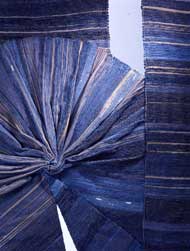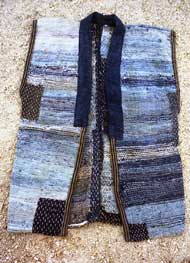The SAKIORI World
Twenty years ago, I met an old indigo-blue dyed kimono lying on the dark shelf of an antique shop. I was filled with desire to revive this blue into contemporary life. This blue color typified the dress of the common people in about a hundred years ago in Japan, and they used to wear these blue kimonos as their working clothes. But gradually they disappeared because of the development of more colorful artificial dying.

The charm of the SAKIORI lies in its sensitive and delicate color that was never expressed by the simple thread. And so is its soft touch and warmth. I want to bring out this charm of the indigo color through this traditional technique. Since then I have been tearing the old indigo kimono clothes for the weft of the SAKIORI, thinking about the ancestor’s joy and sorrow, and dreaming to show the charm of the indigo in this modern world.
My next theme of focus is the eradication of the traditional image that ”SAKIORI is thick and heavy”. I am challenging this idea by creating soft, delicate and even transparent SAKIORI. This will be the revolutionary challenge.
In this 21Century, we must change the mass consumption society to a recycling one. We can say that SAKIORI is the art of the recycle. It shows us the beauty of the past, present and future. Its discovery, reclamation and creation have the possibility to become one region of future art activities.
The Charm of the SAKIORI
The cross section of the strips split finely, and the lurked color emerges unexpectedly, so SAKIORI has very complex color variation. In addition, splits give shades on the surface of the weaving. With these characteristics one can appreciate the charm of SAKIORI .It gives us a warm feeling visually and instantly because the stripped old clothes have their own unique touch which can not be expressed by the simple thread.

SAKIORI was very familiar with the weavers because they could easily get the materials of it near around them. Like a vivid photo, SAKIORI triggers a collection of memories. Its weft, composed of stripes of old clothes, evokes to us the memories of the people and the associated scene. It also gives us the great joy of creation by reviving the once thrown away rugs into useful and beautiful items. Washed out and discolored clothes revive to a much more unique SAKIORI compared to a new one. This surprising beauty is the great joy of SAKIORI.
At the beginning of 1980, the age when old indigo-dyed kimonos were lying on the dark shelf of the antique shop, it was very popular among Kobe people to reshape these kimonos into western style clothes. By chance, I got the stripes of these indigo-dyed clothes and was stunned by the beauty of it. This emotion let me start to weave SAKIORI of old indigo-dyed cloth. Their warm atmosphere-- deep colors, unique touch and delicate shade--charmed me deeply.
Old things were thrown away in those days and clothes were no exception. I intended to breath new life into the antique indigo-dyed clothes which were regarded as “ useless as shabby duster”. These beautiful antique clothes did not fade away and wait for my help. So I devised how to express the beauty of them as the material of my weaving and how to use it variously. From that time, appreciating our ancestor’s work, I have been trying to create my artistic SAKIORI world.
New SAKIORI Expression
Long ago, the birth of Sakiori was realized among poor common people who could not afford new cotton clothes at the time. But in modern times, flooded by numerous ideas and “free thinking” being possible, we can create a “new Sakiori fabric” which is no longer the “reclamation of rags” as it used to be called.
 One can confidently say, “SAKIORI is one good representative of beautiful weaving.”Aesthetic expressions and various angles for new potentiality will grow out from the field of “Sakiori” and a New SAKIORI World will be created. These artistic expressions vary with time and as such new techniques will be born. If we could adapt, in a positive way, to this temporal and spatial trends, I believe that these techniques will not only be welcomed but also modified and passed on to future generations.
One can confidently say, “SAKIORI is one good representative of beautiful weaving.”Aesthetic expressions and various angles for new potentiality will grow out from the field of “Sakiori” and a New SAKIORI World will be created. These artistic expressions vary with time and as such new techniques will be born. If we could adapt, in a positive way, to this temporal and spatial trends, I believe that these techniques will not only be welcomed but also modified and passed on to future generations.
Originally, the charm of Sakiori used to be regarded as “simple and familiar” but I would like to eradicate this conception and search for a “modern, sharp, light and lively” contemporary SAKIORI. For this purpose, I have been trying to bring out as many possibilities of visual and technical effects on these contemporary SAKIORIs as possible.
My conceptions for the contemporary SAKIORI are as follows
Eradication of the idea that Sakiori is thick and heavy.
Widening the avenue of Sakiori's uses.
Recognizing that strips of old clothes
Is good material for artistic weaving
Establishing and proving that Sakiori is fit for contemporary life.
Throughout, I have been groping for ways to revive the Sakiori with two factors in mind. One is for decoration and the other is for everyday use. I have a strong conviction that both points are vital for establishing a “new Sakiori trend”. Indeed, it was a great pleasure in my long adventure for this NEW SAKIORI.
I named these contemporary artistic works as “ SAKIORI FABRIC"and my creative artistic world as “ 裂(SAKU)・Fabric Art”
In Future…
 Every moment I create the Sakiori, I make a new discovery. I am very glad to have found the old indigo-dyed clothes as one of my self-expressions. While I was exploring for ways to express the beauty of the indigo, my interest moved into other colors. Weaving with the old clothes has limited possibilities compared with dying, but their unique colors and feelings drive me wild and give me joy in searching for new avenues
Every moment I create the Sakiori, I make a new discovery. I am very glad to have found the old indigo-dyed clothes as one of my self-expressions. While I was exploring for ways to express the beauty of the indigo, my interest moved into other colors. Weaving with the old clothes has limited possibilities compared with dying, but their unique colors and feelings drive me wild and give me joy in searching for new avenues
I have been mainly involved in developing "new"Sakiori using material obtained from torn clothing. If we could broaden the range of materials employed for Sakiori weaving, I mean, not only using the traditional ones, this area of arts would bring much diversity and skill. Moreover, with the tremendous advancement in modern chemistry, new fibers will be born, paving the way for a more diverse and attractive field of Sakiori. The field would thus grow and grow, and it will be fascinating to witness such a trend of development.
The History of SAKIORI in Japan
SAKIORI is the traditional Japanese rag weaving technique which uses narrow strips of old cloth as its weft. This technique, the use of which was widespread, was born in an era when cloth were very precious.
 SAKIORI became popular in the 18th century (the middle of the Edo period), once ordinary people had access to cotton clothes. Cotton-seed had been introduced to Japan in the mid-17th century, during the early Edo period, and cotton cultivation was developed. Prior to this, the Japanese wore clothes of a linen-like fibre made from wood and grasses that grew locally. These clothes were neither comfortable, nor warm in the winter.
SAKIORI became popular in the 18th century (the middle of the Edo period), once ordinary people had access to cotton clothes. Cotton-seed had been introduced to Japan in the mid-17th century, during the early Edo period, and cotton cultivation was developed. Prior to this, the Japanese wore clothes of a linen-like fibre made from wood and grasses that grew locally. These clothes were neither comfortable, nor warm in the winter.
Cotton spread through the business districts such as Edo (Tokyo today), Osaka, Kyoto and warm regions favourable to cotton farming. In the North of Japan, cotton clothes were a valuable commodity which could only be obtained in exchange for other goods from big cities.
During this period, rice production had increased and the monetary system had been established, meaning that ordinary people could buy soft, warm, cotton fabric. For the lower classes, poor farmers and fishermen however, even second hand clothes were expensive, so they would select the best of them for casual wear or to use as a futon cover. The shabbier items would be patched and stitched for everyday use. Additionally the worn-out clothes would be torn into narrow strips and used in SAKIORI. In this way the poor could finally get to wear cotton, from whence the desire and regard for this fabric.
All over Japan, woodmen and fishermen wore SAKIORI as it provided protection from both the heat of the sun and the winter cold. However, owing to lifestyle changes, and with rapid industrial development leading to cheaper cotton clothes, SAKIORI was soon forgotten. Although it was revived during World War II because of the lack of supplies at this time, it was again abandoned as Japan became wealthy.
In this, the 21st century, SAKIORI has once again been brought into the spotlight as we re-evaluate handmade products and traditional arts and crafts. The more people understand its cultural value, the better they appreciate the unique texture and the beauty of SAKIORI.
